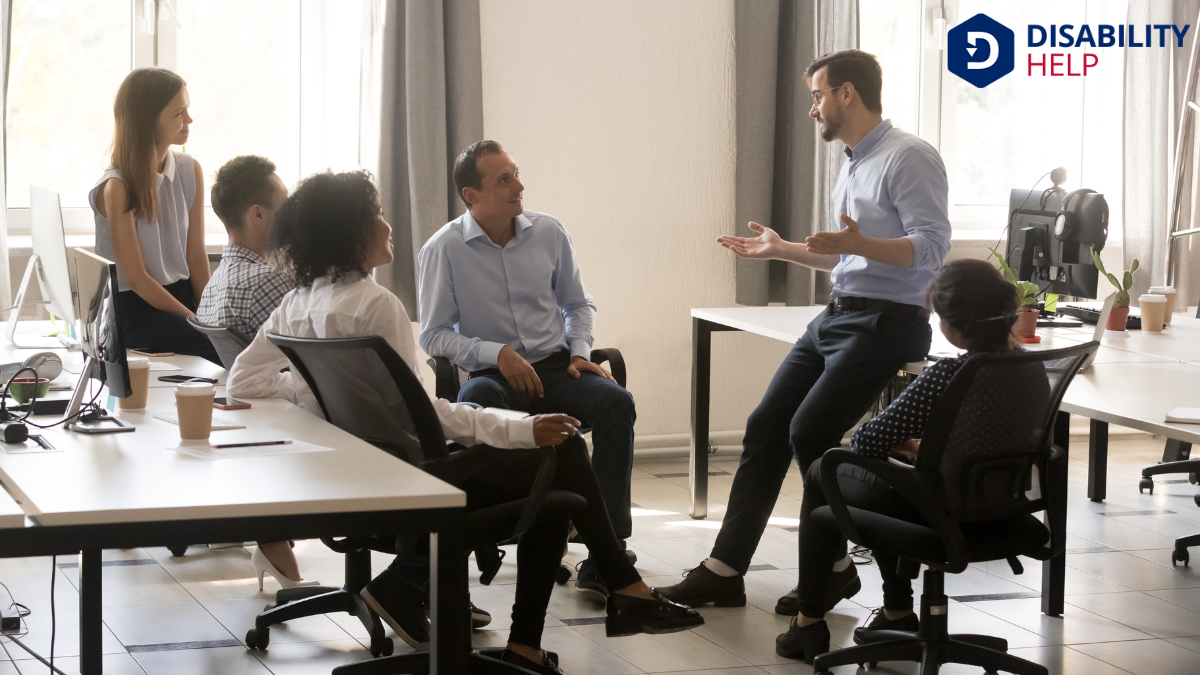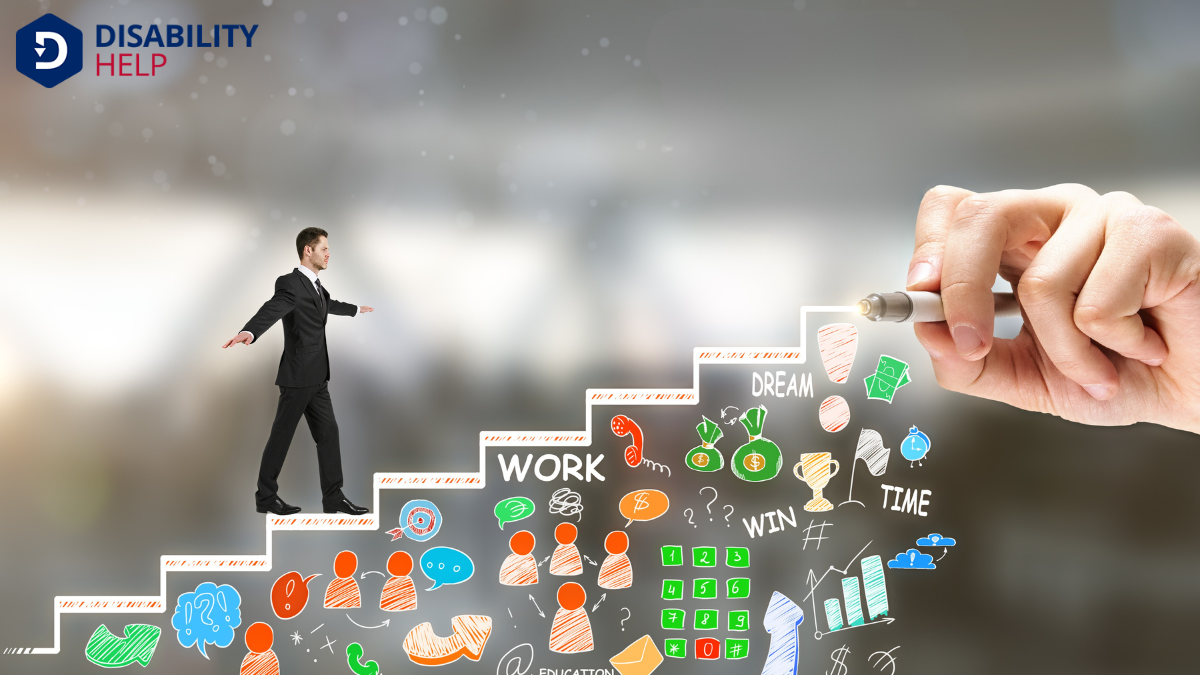Yes, there are mentorship programsPrograms that pair individuals with disabilities with experienced professionals to provide guidance ... designed for employees with disabilities, helping bridge gaps in understanding and accessibilityThe design of products, devices, services, or environments to be usable by people with disabilities.... within the workplace. These programs offer personalized guidance to navigate challenges, enhance career developmentThe process of managing life, learning, and work over the lifespan, including for individuals with d..., and connect individuals with experienced mentors. By utilizing technology and diverse mentorship strategies, they create inclusive environments where everyone feels valued and supported. Discovering more about these programs will reveal their profound impact on career advancement and organizational inclusionThe practice of creating environments in which any individual or group can be and feel welcomed, res....
Key Takeaways
- Yes, there are mentorship programs specifically designed for employees with disabilities to enhance their career development.
- These programs offer traditional one-on-one, peer, group, and reverse mentorship options tailored to disability-related challenges.
- Assistive technologies, like screen readers and speech-to-text software, are utilized to make mentorship accessible.
- Virtual mentorship platforms provide flexible, geographically-unrestricted connections for mentors and mentees with disabilities.
- Organizations are increasingly implementing inclusive mentorship initiatives to foster diverse and supportive workplace environments.
Understanding the Importance of Mentorship for Employees With Disabilities
While many of us recognize the general benefits of mentorship, it’s important to highlight its specific impact on employees with disabilities. By fostering an inclusive environment, mentorship can bridge gaps in understanding and accessibility.
We understand that maneuvering workplace challenges can sometimes feel overwhelming, but having a mentor provides tailored guidance and support. Mentors help us identify opportunities for growth and offer insights that might otherwise be overlooked.
Together, we can address specific needs and break down barriers that might hinder professional development. It’s vital for organizations to facilitate these connections, ensuring that all employees feel supported and valued.
Key Benefits of Mentorship Programs for Disabled Employees

Let's explore how mentorship programs can make a real difference for disabled employees.
These programs enhance career development, boost confidence levels, and foster workplace inclusionThe practice of creating a work environment where individuals with disabilities are fully integrated....
Enhanced Career Development
Mentorship programs for employees with disabilities greatly enhance career development by offering personalized guidance and support tailored to individual needs.
These programs connect us with experienced mentors who understand the unique challenges we face, helping us navigate workplace dynamics more effectively.
Through mentorship, we gain access to valuable resources and networks that may otherwise be difficult to reach.
This connection opens doors to new opportunities and insights, allowing us to explore career paths we mightn't have considered.
Increased Confidence Levels
Building on the career development benefits, mentorship programs also greatly boost our confidence levels. When we engage in these programs, we gain valuable insights and feedback that empower us.
Having a mentor who understands our unique challenges can help us view situations from different perspectives. This support encourages us to step out of our comfort zone and take on new challenges. As we successfully navigate these situations, our self-assurance grows.
Moreover, mentors provide a safe space for us to discuss our concerns and build our self-esteem. They celebrate our achievements and offer guidance when we encounter setbacks.
Improved Workplace Inclusion
When we participate in mentorship programs, we often find that workplace inclusion greatly improves.
These programs create a bridge, fostering understanding between employees with disabilities and their colleagues. Mentors, equipped with insights and resources, help us navigate the workplace, ensuring our contributions are recognized and valued.
This collaboration not only enhances our professional development but also cultivates a more inclusive environment.
Challenges Faced by Employees With Disabilities in the Workplace
Despite significant progress in workplace inclusivity, employees with disabilities still encounter a range of challenges that can hinder their professional growth.
We must acknowledge and address these barriers to cultivate a more supportive environment.
Some of the main challenges include:
- Accessibility Issues: Inadequate accommodationsModifications or adjustments in healthcare settings to support patients with disabilities., such as inaccessible workspaces or technology, can limit participation.
- Bias and Stereotypes: Prejudices or misconceptions about capabilities can affect opportunities for advancement.
- Communication Barriers: Lack of inclusive communication tools and practices can lead to misunderstandings and isolation.
- Limited Career Development: Fewer networking or training opportunities can restrict career growth.
Types of Mentorship Programs Available
Acknowledging the challenges faced by employees with disabilities is just the beginning; we also need to actively support their professional journeys.
One way we can do this is by providing diverse mentorship programs tailored to their unique needs. Traditional one-on-one mentorship focuses on pairing an employee with an experienced mentor who offers guidance and support.
Another approach is peer mentoringA relationship where a more experienced individual with a disability provides guidance and support t..., where individuals at similar stages in their careers share experiences and provide mutual support.
Group mentorship programs involve multiple mentors and mentees, fostering a community of shared learning and networking.
Reverse mentorship flips the conventional model, allowing younger employees to mentor senior staff, promoting inclusive perspectives.
Tailoring Mentorship Programs to Meet Diverse Needs

As we consider how to tailor mentorship programs, focusing on inclusive mentorship strategies is essential to addressing the unique needs of employees with disabilities.
By implementing personalized support approaches, we can guarantee that each individual's strengths and challenges are acknowledged and addressed.
Let's explore how these methods can create a more supportive and effective mentorship environment for everyone involved.
Inclusive Mentorship Strategies
When crafting mentorship programs for employees with disabilities, it’s crucial to tailor our strategies to accommodate diverse needs.
By being inclusive, we create environments where everyone feels valued and supported.
Let’s consider some effective strategies:
- Flexible Communication: AdaptA grassroots disability rights organization in the U.S. that focuses on promoting community-based se... communication methods to suit individual preferences, whether through verbal, written, or visual means.
- Accessible Resources: Verify all mentorship resources and materials are available in accessible formats, such as braille or audio.
- Diverse Mentor Matching: Pair mentors and mentees based on shared experiences or challenges to foster understanding and growth.
- Feedback Opportunities: Regularly seek feedback from mentees to continuously improve the mentorship experience.
Personalized Support Approaches
To truly cater to the unique needs of employees with disabilities, we must embrace personalized support approaches in our mentorship programs. By doing so, we acknowledge that each individual’s experiences and challenges are distinct. This means tailoring our mentorship strategies to align with their specific goals and capabilities.
When we take the time to understand their needs, we can foster a supportive environment that encourages growth and development.
We should actively engage with mentees, asking open-ended questions to uncover their aspirations and potential obstacles. This dialogue allows us to adapt our guidance and resources accordingly.
How to Find a Suitable Mentorship Program
Where do we begin when searching for a mentorship program that truly caters to employees with disabilities?
We first need to identify programs that align with our specific needs and goals.
Let’s explore some strategies to find the right fit:
- Research Online Platforms: Many online resources list mentorship programs focused on disability inclusionThe practice of ensuring that individuals with disabilities have equal access to employment opportun.... Websites like LinkedIn or industry-specific forums can be helpful.
- Reach Out to Professional Networks: We can ask colleagues or industry groups if they know of any programs.
- Check with HR Departments: Our workplace's HR department may have information on available programs tailored for employees with disabilities.
- Contact Disability Organizations: National or local disability organizations often have connections to mentorship programs designed for our unique requirements.
The Role of Technology in Enhancing Mentorship for Disabled Employees
Let's explore how technology can revolutionize mentorship for employees with disabilities.
Virtual mentorship platforms allow us to connect mentors and mentees regardless of geographical barriers, creating a more inclusive environment.
Additionally, assistive technology tools enable personalized support, ensuring that all participants can engage fully and effectively in the mentorship process.
Virtual Mentorship Platforms
Although technological advancements have revolutionized countless industries, one of their most significant impacts is on mentorship programs for employees with disabilities. Virtual mentorship platforms break down geographical barriers, allowing us to connect with mentors worldwide.
They offer flexible scheduling, which means we can engage in mentorship sessions that fit our individual needs and timelines. This flexibility is essential for accommodating various accessibility requirements.
Let's explore some benefits of virtual mentorship platforms:
- Increased Accessibility: We can connect with mentors regardless of location.
- Flexible Scheduling: Sessions can occur at times most convenient for us.
- Diverse Perspectives: Access to a wider pool of mentors enriches our learning.
- Cost-Effective: Eliminates travel expenses and reduces time constraints.
These platforms help guarantee that mentorship is inclusive and effective for all.
Assistive Technology Tools
Assistive technology tools play a pivotal role in enhancing mentorship experiences for employees with disabilities. They empower us to bridge communication gaps and foster inclusive environments.
Tools like screen readers, speech-to-text software, and adaptive devices enable seamless interaction between mentors and mentees, ensuring everyone has equal accessThe principle that all individuals, including those with disabilities, should have equal opportunity... to valuable guidance and resources.
As we explore these technologies, it's essential to understand their impact on learning and development. For instance, video conferencing platforms equipped with real-time captioning allow us to engage in meaningful discussions, irrespective of hearing impairments.
Furthermore, customizable interfaces cater to various needs, ensuring a personalized experience.
Success Stories: Real-life Impact of Mentorship on Career Advancement

When considering the transformative power of mentorship programs, we find countless success stories that vividly illustrate their impact on career advancement for employees with disabilities.
These stories aren't just numbers; they're journeys of growth and empowermentThe process of gaining control, authority, and power over one’s life, often used in the context of....
Let's explore some of these inspiring outcomes:
- Increased Confidence: With a mentor's guidance, many employees gain the confidence to tackle challenges and pursue leadership roles.
- Skill Development: Mentorship often leads to acquiring new skills that are vital for career progression.
- Expanded Networks: Mentees frequently build valuable professional networks, essential for exploring new opportunities.
- Promotion and Recognition: Success stories often include promotions and increased recognition within their organizations.
These examples highlight how mentorship can truly reshape career paths and reveal potential for employees with disabilities.
Strategies for Organizations to Implement Effective Mentorship Programs
Building on the inspiring success stories, we now turn our focus to strategies that organizations can employ to create effective mentorship programs for employees with disabilities.
First, we must foster an inclusive culture that values diversityThe inclusion of individuals from a wide range of backgrounds, including people with disabilities. and accessibility. This involves training mentors to understand the unique challenges faced by employees with disabilities.
Next, pairing mentors and mentees based on shared interests and career goals can enhance engagement and learning. Regular feedback sessions will help us evaluate the program’s effectiveness and make necessary adjustments.
Additionally, leveraging technology, such as virtual meeting platforms, can bridge geographical barriers and create flexible mentoring opportunities.
Future Trends in Mentorship Programs for Employees With Disabilities
As we look ahead, it's clear that future trends in mentorship programs for employees with disabilities will be shaped by technological advancements and evolving workplace dynamics.
We'll see more virtual mentorships, enhancing accessibility and flexibility. Technology will help us bridge gaps and tailor mentorship experiences to individual needs.
Key trends include:
- AI-driven platforms: These will customize mentorship plans by analyzing skill sets and growth areas.
- Remote mentorship opportunities: These will increase, allowing us to connect globally and offer diverse perspectives.
- Inclusive technologies, Such as screen readers and voice recognition, will guarantee equitable access to resources.
- Hybrid mentorship models: Combining in-person and digital interactions, they'll cater to varied preferences and needs.
Embracing these trends, we'll create more inclusive and effective mentorship environments.
Conclusion
In wrapping up, we recognize the essential role mentorship programs play in supporting employees with disabilities. By understanding their unique challenges and tailoring programs to meet diverse needs, we can foster a more inclusive workplace. Let's embrace technology to enhance these initiatives and learn from success stories to inspire others. As organizations, it's up to us to implement effective strategies and stay ahead of future trends, ensuring every employee has the opportunity to thrive.






